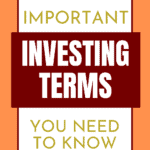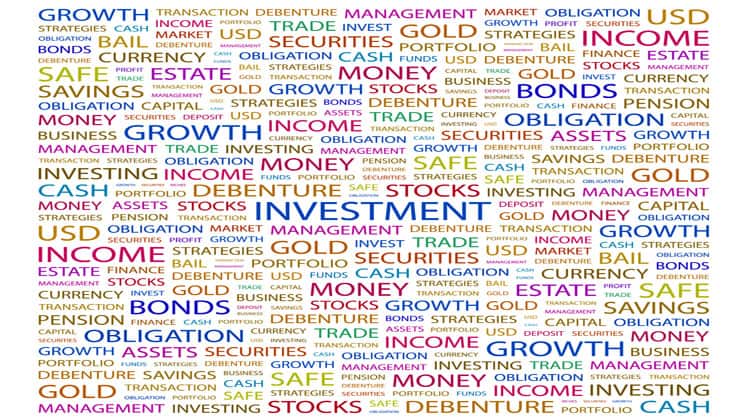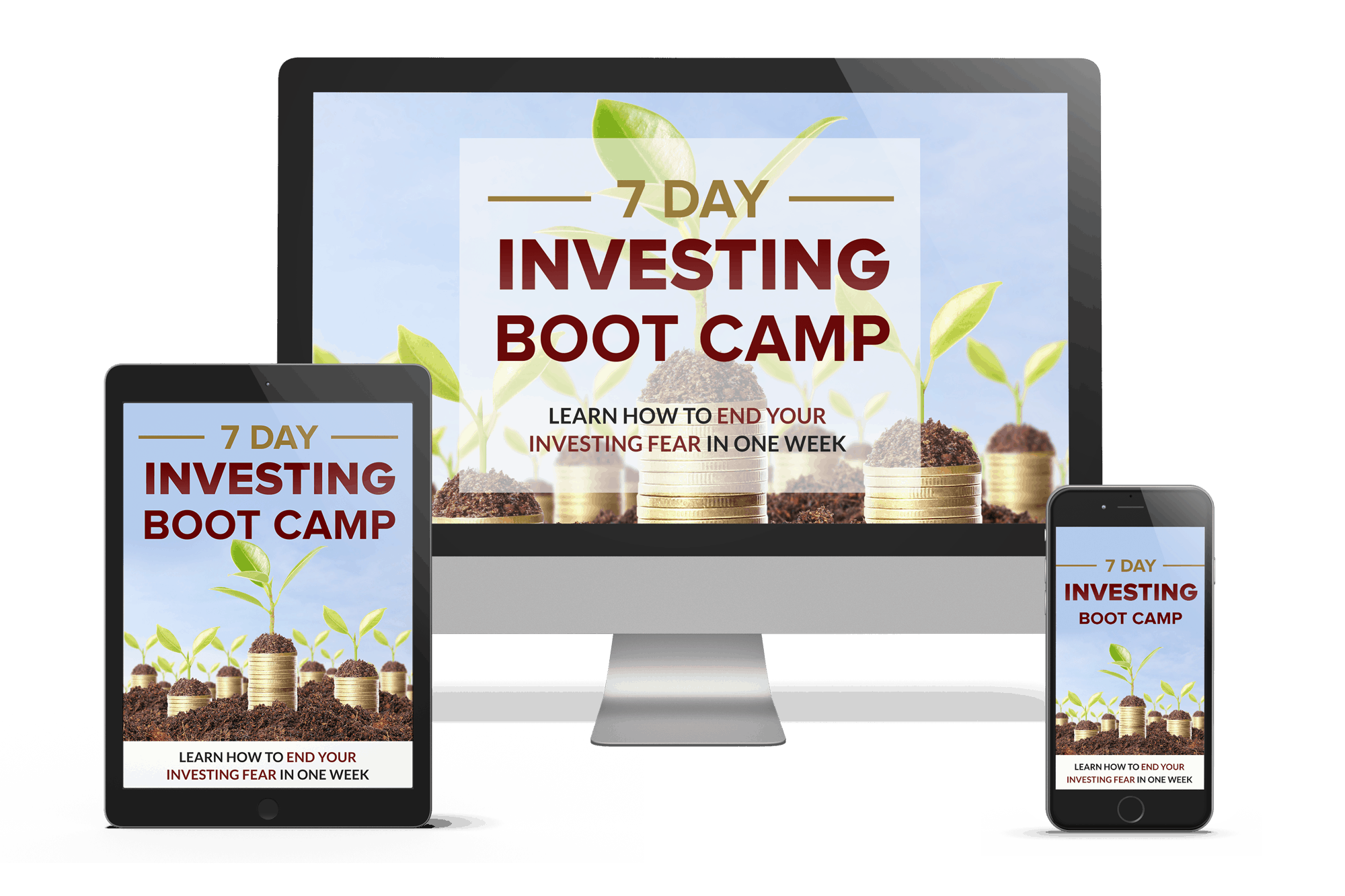THIS POST MAY CONTAIN AFFILIATE LINKS. PLEASE SEE MY DISCLOSURES. FOR MORE INFORMATION.
Investing can be confusing.
Not only are there many different types of investments to invest in, there are many terms that are thrown around as well.
Many times these terms make investing hard to understand.
As a result, I put together this list of common investment terms.
The goal is to help you better understand these investing terms so you can be a smarter investor and because of this, be a successful investor as well.
By understanding these terms along with the basics of investing, you should be able to grow your wealth in the stock market.
Table of Contents
Common Investment Terms You Need To Know
Cash
As the name suggests, cash refers to fiat currency in the form of notes or bills.
Cash can be used to purchase goods and services, and it’s essential to have cash for day-to-day expenses, savings, and investment opportunities.
Understand that cash, or money, can come in different forms.
You can have paper money or coins that can be used as legal tender.
Stocks
Stocks refer to a type of security that is used to indicate ownership within a company.
Individual stocks are separated into smaller units known as shares.
- Read now: Find out how to become a stock market millionaire
- Read now: Learn the investing basics you need to know
When you purchase a share, you invest in the company selling these shares and can realize a profit in the form of dividends or capital gains when you choose to sell your shares.
There are different classes of stock as well as advantages and disadvantages that come with each type.
The main asset classes most investors deal with are large cap stocks, small cap stocks, mid-cap stocks, international stocks, and emerging markets stocks.
- Read now: Find out the pros and cons of small cap stocks
- Read now: Here are the pros and cons of large cap stocks
Bonds
A bond is a type of debt securities that offers fixed interest to the investor.
Corporate bonds allow a company to borrow money, which will be paid back over time.
Government bonds are another type of bond that one may encounter during your investment journey.
They work the same way as a corporate bond, the only differences are they are issued by a government and they tend to have a lower interest rate.
Bonds have a fixed maturity date as well as fixed interest rates and specific loan terms.
These assets can be used to receive regular interest payments on your initial loan amount over time, rather than investing in assets that are designed to pay out immediately.
Cashing out your bond earlier than the maturation date can result in a loss of interest payments and other consequences.
The value of bonds is $1,000 which makes investing in individual bonds tricky for many investors.
As a result, you can turn to a mutual fund or and ETF and invest in a bond fund.
This is an investment that has a pool of bonds to invest in, as opposed to buying a single bond.
Mutual Funds
Aptly named, a mutual fund is a professionally managed investment fund that leverages funds pooled together by investors to purchase a variety of securities like stocks or bonds, etc.
This type of investment exists to lower risk for those who invest due to diversification opportunities as well as professional management.
- Read now: Here are the basics of mutual funds to know
- Read now: Learn the pros and cons of mutual funds
Mutual funds can be set up in different ways, but they are typically set up as either open-end funds or closed-end funds.
Open end mutual funds give investors the right to purchase more mutual fund shares at their discretion with no limit on how much an investor can invest.
Closed end mutual funds have a fixed number of shares that are listed and traded on a stock exchange.
Load Mutual Funds
Load mutual funds are investment vehicles that carry a sales charge or commission in order to buy and or sell.
The investor pays the fee and the money goes to the broker or salesperson who sold them the mutual fund.
A typical front end load charge is 5.75%.
This means if you invest $100 into a load mutual fund with this sales charge, $5.75 would go to the financial professional who sold you the fund and you would invest the remaining $94.25.
Understand that this fee is charged every time you make a new investment.
It is not charged if you reinvest dividends.
Some mutual funds charge a back end load when you sell.
This is typically done to limit short term traders from the fund.
No Load Mutual Funds
No load mutual funds are investment vehicles that do not have a sales charge.
An investor can invest in these no load funds with or without the help of a financial advisor or broker.
When you invest in these, 100% of your money goes into the fund.
Active Management
This is an investment philosophy where fund managers buy and sell securities with the goal of earning a higher return than the stock market indexes.
The rate of buying can selling varies by fund manager among other variables.
Most mutual funds are actively managed, however there are some passive mutual funds as well.
On the flip side, most exchange traded funds are passively managed and few are actively managed.
Passive Management
This is the opposite investment philosophy from active management.
With passive investing, a fund manager buys securities to reflect an underlying index and then holds these securities.
The goal is to match the return of the underlying index.
A number of mutual funds offer index funds and most ETFs offer them as well.
Hedge Funds
A hedge fund is similar to a mutual fund in that it pools investors money together to make investments.
But it differs drastically from there.
First, it is managed as a partnership, where the portfolio manager is the active partner and the investors are the passive managers.
Next, in order to invest, you need to have earned income of $200,000 or more for the previous two years, or a net worth of $1 million.
Finally, hedge funds can invest in all sorts of exotic investments, including derivatives to try to increase it’s potential return.
The fees on this investment vehicle vary, but usually hover around 1.5%, plus a 15% performance fee on gains.
Exchange Traded Funds
An exchange traded fund, better known as an ETF, are similar in nature to mutual funds.
- Read now: Discover more about ETFs
Put simply, they behave like stocks but are composed of a variety of securities.
Additionally, exchange traded funds are actively traded throughout the day and can vary in focus from one type of asset to a collection of assets.
ETFs are typically very affordable due to their easy access and low commission fees.
Diversification
The phrase, “never put your eggs in one basket” perfectly summarizes the definition of diversification.
Diversification is used to describe the act of investing your money to buy multiple types of securities and assets rather than solely investing in one type of asset.
Diversification is necessary to minimize risk from your investment activity and ensure that you still have investment funds even if one type of asset doesn’t perform as expected.
Asset Allocation
Asset allocation is a type of investment strategy that assesses an individual’s investment goals, risk tolerance, and investing time horizon to create an appropriate investment strategy.
- Read now: Find out your ideal asset allocation
By following an allocation model, you invest in a way that will help you to best achieve your financial goals.
If you have specific investing goals, you need to understand your ideal allocation.
Portfolio
An investment portfolio refers to a collection of investments that you have made.
A portfolio may also refer to a collection of investments in the form of a fund, such as an ETF or mutual fund.
As stated above, making sure that you have a diversified portfolio is crucial to maintaining your investments and mitigating risks.
Expense Ratio
An expense ratio is the fee shareholders pay to the management team for professionally managing their investments.
The expense ratio may be expressed in terms of annual fees or in percentage terms.
Mutual funds and exchange traded funds are the investments that charge this fee, which also goes by management fees.
The fees vary by mutual fund and the type of fund it is.
For example, active funds have higher fees than passive funds.
Additionally, stock funds have a higher fee than bond funds.
Index Fund
Index funds are a mutual fund or exchange traded fund that invests their money to match an underlying index.
The goal of an index fund is to earn the same return as the index, such as the S&P 500 Index.
- Read now: Discover why so many people invest using buy and hold
- Read now: See the pros and cons of index funds
Because they tend to be investments that buy and hold as opposed to trading securities on a regular basis, they have lower fees.
And studies show that most investors are best suited for index funds simply because of how easy they make investing as well as for their low fees.
Target Date Funds
Target date funds are a type of mutual fund that uses asset allocation and the principle of diversification to determine your ideal target date for retirement.
These funds automatically change their assets as you approach this milestone, which creates an easy way to invest in multiple types of securities without doing all the research yourself.
- Read now: Find out more about target date funds
- Read now: Here are the pros and cons of target date funds
For example, if you are far away from retirement, your allocation might be 70% stocks and 30% bonds.
In 20 years, this fund could have an allocation of 50% stocks and 50% bonds.
And as you get even closer to retirement age, the fund could invest in 20% stocks and 80% bonds.
By doing this, you automatically reduce risk, protecting your money from large losses.
Taxable Account
A taxable account is an investment account that has you paying income tax on the money it earns.
The money you earn is called capital gains and losses are called capital losses.
They have different tax rates depending on the situation.
Also taxed in these accounts will be any dividends you receive.
Again, the tax on this income will vary as well.
Typically, taxable accounts are just for your general investments and not retirement funds such as 401(k)s or Roth IRA’s.
Because of the way taxes work, it is advised that you keep bond holdings mostly out of taxable accounts as these investments can have a large tax impact on your financial situation.
Custodial Account
This is an account that is set up for a minor and controlled by an adult.
These accounts exist since minors cannot open accounts or invest on their own until they reach the age of majority in their state.
There are many benefits to these types of accounts, including no contribution limit, no withdrawal penalty, and tax benefits.
Individual Account
An individual brokerage account is a taxable account set up on one person’s name and that person owns 100% of the assets in the account.
Joint Account
A joint account is a taxable brokerage account that you set up with two account holders.
Typically these are set up between spouses, but this is not required.
They work the same way as an individual brokerage account works.
The only difference is that each owner has 50% ownership of the account assets.
Beneficiary
A beneficiary is a person or entity you name to take ownership of an asset once you pass.
Commonly, a beneficiary is set up for investment accounts so that the account does not go into probate, assuming there is no will.
You can set up a single or multiple beneficiaries in your account, and you can specify the ownership percent each one gets.
Tax-Deferred Account
When you invest in a 401k or individual retirement account, your money is taxed at the time of withdrawal rather than when it accumulates interest and returns while being invested.
- Read now: Learn about the popular types of retirement accounts
- Read now: Here are the best retirement calculators to see if you are on track
This offers an advantage over taxable accounts because gains on a tax-deferred account are not taxed until they’re withdrawn.
However, that also means if you withdraw from the account before retirement age you will pay income tax as well as additional penalties.
Fiduciary
Of all the investing terms, this one is critical you know and understand.
Fiduciary responsibility means that the professional who manages your money or investments, typically in either a fee-based structure or as an investment advisor, has to put your interests first.
This person will manage the investment portfolio according to your preferences and goals laid out at the beginning of their relationship with you.
All fees charged by this person must be clearly outlined before moving forward with any potential financial transaction.
A fiduciary is held to a higher standard than other financial professionals because they are managing someone’s money and livelihood.
As a result, they have to do what is in your best interest.
This means if there are two investment choices that are virtually identical but one charges a higher fee, they must put you in the lower fee investment.
And if they are earning a commission on any recommendation, they need to disclose this.
Contrary to popular belief, not all advisors are fiduciaries.
This means they can put you into investments they earn commissions on without disclosing to you.
Financial Advisor
A financial advisor offers guidance and investment advice to clients for a fee.
Some advisors also offer tax planning, estate planning services, and insurance products.
Registered advisers need to be pass exams and be licensed in the state to work with clients.
Financial Planner
Financial planners work with clients to understand their goals and risk tolerance to determine the appropriate investments for them.
In addition to investments, financial planners also offer tax planning, retirement planning and estate planning services.
Some financial planners hold the Certified Financial Planner credential, which holds them to a higher standard.
Traditional IRA
A traditional individual retirement account is a retirement plan that allows you to invest a certain amount of money each year and take deductions on your taxes.
The money grows tax deferred, meaning you do not pay any taxes on the income or gains until you withdraw the money.
If you withdraw the money before age 59 1/2, not only will you pay taxes, but also penalties.
Also note that when you turn age 72, you are required to start taking distributions from these accounts.
Roth IRA
A Roth IRA is a retirement account that offers tax benefits when saving for your golden years.
The major difference in this type of plan compared to traditional IRAs are the contributions you make to these accounts have already been taxed, so when you withdraw money from the account at age 59 1/2, the money is not be subject to income taxes.
- Read now: Learn how to contribute to a Roth IRA regardless of your income
- Read now: Here are the pros and cons of a Roth IRA
Also, with a Roth IRA, there is no requirement to take distributions when you turn age 72.
Finally, since your contributions to the account are already taxed, you can withdraw this money without penalty before age 59 1/2.
Understand this only applies to your contributions and not earnings.
For example, if you contribute $2,000 and your account is now worth $14,000 you can take the $2,000 out for any reason without taxes or penalties.
401k Plan
A 401k plan is a retirement savings account that you can invest in through your employer.
The contribution limits on these plans are much higher compared to individual retirement accounts.
The money contributed to this account comes out of your salary, meaning it reduces your taxable income for the year and saves you on taxes.
- Read now: Learn the pros and cons of 401k plans
If you withdraw from these accounts before age 59½, not only will be subject to standard tax rates, but you will also have to pay an additional penalty for early withdrawal.
In many cases, employers will match your contributions with what is called an employer match.
This is essentially free money as it is 100% from the employer and not your salary.
Solo 401k Plan
A solo 401k plan is similar to a traditional 401k plan, except that it is designed for entrepreneurs to save for retirement.
The major difference with a solo 401k plan is that you can contribute more to the plan than an employee can contribute to a 401k plan.
SEP IRA
A SEP IRA or a simplified employee pension plan, allows employers to make contributions to the retirement plan for the benefit of the employee.
A self-employed person can also make both employer and employee contributions on their own behalf.
Contributions are tax deductible and the contribution limits are higher when compared to Traditional IRAs.
Rollover IRA
A Rollover IRA is when you take a 401k or 403b plan and convert it into a Traditional IRA.
This usually happens when you quit a job or move to another employer.
The rules for a Rollover IRA are similar to a Traditional IRA.
403b Plan
A 403b is similar to a 401k plan, with the main difference is that it is for people who work for tax-exempt or not for profit businesses.
A 403b is also referred to as a tax-sheltered annuity plan.
The amount you can contribute to a 403b plan is the same as a 401k plan.
Required Minimum Distribution
Required minimum distributions (RMDs) are the amount of money that older investors must withdraw from their retirement accounts each year by December 31.
If they don’t take RMDs, they will face a number of penalties.
In the past, the age to start taking RMDs was 70 1/2 but was recently increased to age 72.
Note that a required minimum distribution does not apply to Roth IRAs.
Alternative Investments
Alternative investments are any investment that is not a stock, bond or mutual fund.
This includes things such as money market accounts, certificates of deposit (CDs), artwork, real estate, commodities, collectibles, and precious metals.
In some cases, it can be beneficial to have some of your money invested in these vehicles as it is a way to further diversify your investments.
However, it is important you understand the risks involved before diversifying into this asset class.
Because of this, many financial professionals recommend this asset class make up 10% or less of your total portfolio.
Stock Market
The stock market is an exchange where shares of publicly listed companies are traded.
Buyers and sellers meet to exchange shares of stock and take profits and losses from these transactions.
While most people think of the stock market as one thing, there are many exchanges where individual stocks trade.
In the United States, the most popular exchanges are the Dow Industrial Average, the S&P 500, and the NASDAQ.
Typically when you hear people referring to the stock market and its actions, they are talking about the Dow Industrial Average.
Bull Market
A bull market is when the stock market rises for an extended amount of time, usually over the course or months or year.
While not all stocks will rise during this time, the majority do.
Traders define this type of market when stock prices rise 20% or more after a decline of 20%.
The average bull market lasts roughly 4 years, however each one is different, with some lasting much less and other lasting longer.
The average rise in prices during this time is 112%.
Bear Market
A bear market is the opposite of a bull market.
This is when the stock market declines for an extended amount of time.
This usually happens over the course of months or years.
Traders define this type of market when stock prices fall 20% or more after rising 20%.
The average bear market lasts around 9 months and the average drop in the stock market is 36%.
Recession
A recession is a decline of economic activity.
It is usually signaled by two consecutive quarters of falling gross domestic product or GDP.
While a recession has mainly to do with a country’s economy, a recession does impact the stock market as well.
With falling economic activity, business growth slows and many times the stock market falls into a bear market.
Correction
A correction is when the stock market drops at least 10% from its high.
It is still considered a correction if stocks drop 19.9% as well.
After this, it is considered a bear market.
The important thing to remember about corrections is they happen all the time.
In fact, some times there are multiple corrections a year, while other times, we can go years without one.
While they can be scary, a correction is a healthy part of a strong stock market.
Volatility
Volatility is the up and down movement in the stock market.
The volatility can vary by day and time of year.
Not all times are high volatility.
Traders define a volatile market if it rises or falls more than 1% over a period of time.
In terms of specific securities, higher volatility is related to riskier securities.
Dividend
A dividend is money that a publicly traded company pays to its shareholders.
It’s considered one way that corporations reward their owners with profits.
Not all companies pay dividends.
Larger, slower growing companies tend to pay dividends because their stock prices do not increase in value like smaller, faster growing companies.
Most dividends are paid out quarterly.
Traditionally cash dividends are the norm, however in some special circumstances, a company may pay out a stock dividend.
Capital Gains
Capital gains occur when an investor sells an asset and realizes a gain on the sale price.
This occurs when the selling price exceeds what was originally invested.
There are two types of capital gains, short term and long term.
Short Term Capital Gains
Short term capital gains are when you sell an asset for a profit that you have held for less than one year.
These gains are taxed like ordinary income and the rate you pay is based on your tax bracket.
- Read now: Learn how to pay taxes like the wealthy
- Read now: Discover the difference between tax credit vs. tax deduction
Long Term Capital Gains
Long term capital gains are when you sell an asset for a profit that you have held for longer than one year.
These gains are taxed at either a 0%, 15%, or 20% tax rate.
The rate you pay depends on your taxable income.
Dollar Cost Averaging
Dollar cost averaging is the systematic buying of an investment on a regular basis.
The idea is that since an investor cannot know what the market is going to do, they are better off investing a small amount of money on a recurring basis.
- Read now: Learn what is better lump sum investing vs. dollar cost averaging
- Read now: Discover the difference between market timing vs. time in the market
For example, if you have $10,000 to invest, instead of investing it all at once, or in a lump sum, you invest smaller amounts.
You could invest $1,000 monthly for 10 months.
Or $2,500 every 4 months.
Fractional Shares
Fractional shares are when you buy partial shares of individual stocks.
In the past, you could only purchase whole shares, like 1, 25, or 64.
But thanks to technology, many online brokers now offer the ability to buy fractional shares.
This opens the door to individual investors who don’t have a lot of money to invest.
It also allows you to invest in high priced stocks as well.
Micro Investing
Micro investing is dollar cost averaging on a smaller scale.
Here you invest $5 or $10 a month, every month.
There are many investment apps that allow for you to micro invest, including Stash and Acorns.
- Read now: Learn why investors love Acorns
- Read now: See my full review of Stash
While some might not think investing such small amounts is worth it, thanks to compounding, these small investments add up over time.
Full Service Brokerage
This is an investment firm that provides a variety of services to individual investors.
This includes retirement planning, investing research and advice, tax tips, and more.
Some offer banking services and loans as well.
This is in addition to investing in the stock market.
Discount Brokerage
A scaled down investment firm.
These firms do not offer all the extras to investors like retirement planning or research.
They mainly allow for investors to invest at a lower cost.
Robo-Advisor
A robo-advisor is a digital financial advisor that helps investors to invest in the stock market.
The majority of robo-advisors have pre-built investment portfolios based on Modern Portfolio Theory.
- Read now: Click here to learn about Betterment
- Read now: Find the best online broker for you
They automate investing as well as other investing related services to help investors earn a higher rate of return.
Some offer investment advice as well and most offer limited human interaction.
Final Thoughts
There are the common investment terms you need to be familiar with.
By knowing these terms, you make yourself a smarter investor, which only increases your odds of successful investing and growing your wealth.
Don’t be turned off or scared of the stock market because of the investing terms.
While some are more complicated to understand, most are easy to know and as a result, there is no excuse not to familiarize yourself with them.
- Read now: Learn the biggest investing risks investors face
- Read now: Discover why Dave Ramsey’s investment advice is bad
- Read now: See why you are your greatest enemy when investing
I have over 15 years experience in the financial services industry and 20 years investing in the stock market. I have both my undergrad and graduate degrees in Finance, and am FINRA Series 65 licensed and have a Certificate in Financial Planning.
Visit my About Me page to learn more about me and why I am your trusted personal finance expert.







